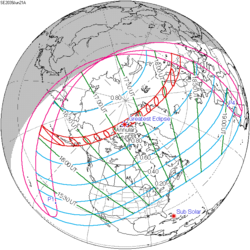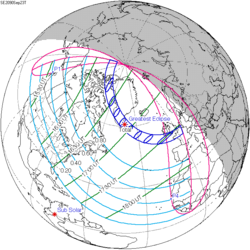| Total eclipse | |
| Gamma | −0.7246 |
|---|---|
| Magnitude | 1.0413 |
| Maximum eclipse | |
| Duration | 238 s (3 min 58 s) |
| Coordinates | 24°48′S139°06′E / 24.8°S 139.1°E |
| Max. width of band | 201 km (125 mi) |
| Times (UTC) | |
| Greatest eclipse | 2:40:36 |
| References | |
| Saros | 127 (59 of 82) |
| Catalog # (SE5000) | 9591 |
A total solar eclipse will occur at the Moon's ascending node of orbit on Monday, July 13, 2037, [1] with a magnitude of 1.0413. A solar eclipse occurs when the Moon passes between Earth and the Sun, thereby totally or partly obscuring the image of the Sun for a viewer on Earth. A total solar eclipse occurs when the Moon's apparent diameter is larger than the Sun's, blocking all direct sunlight, turning day into darkness. Totality occurs in a narrow path across Earth's surface, with the partial solar eclipse visible over a surrounding region thousands of kilometres wide. Occurring about 2.6 days before perigee (on July 15, 2037, at 17:50 UTC), the Moon's apparent diameter will be larger. [2]
Contents
- Images
- Eclipse timing
- Places experiencing total eclipse
- Places experiencing partial eclipse
- Eclipse details
- Eclipse season
- Related eclipses
- Eclipses in 2037
- Metonic
- Tzolkinex
- Half-Saros
- Tritos
- Solar Saros 127
- Inex
- Triad
- Solar eclipses of 2036–2039
- Saros 127
- Metonic series
- Tritos series
- Inex series
- Notes
- References
- External links
Totality will be visible from parts of Australia (including the center of Brisbane and the Gold Coast, as well as Geraldton, Western Australia) and New Zealand. A partial eclipse will be visible for parts of Indonesia, Australia, and Oceania.



































































































